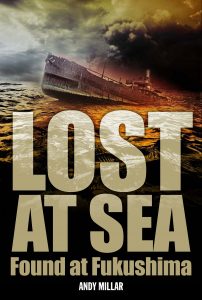- Author
- Book reviewer
- Subjects
- Ship histories and stories, History - WW2
- Tags
-
- RAN Ships
- None noted.
- Publication
- March 2012 edition of the Naval Historical Review (all rights reserved)
Lost at Sea – Found at Fukushima by Andy Millar. Published by Big Sky Publishing, Sydney, 2012 – to be launched in March. Hard cover, 260 pages with b&w photographs and illustrations. rrp $29.99.

This biography starts and ends in December 2003 in the township of Keri Keri in New Zealand’s picturesque Bay of Islands, at the funeral service of David Millar, far removed from the story which unfolds. David Millar was the author’s remote father who kept his darkest memories hidden, to be rediscovered in memorabilia stored in a cardboard box found in the retirement village where he died. Andy Millar was obviously moved by what he found about his father’s life which was largely unknown to his children. Now retired, after 40 years experience in the Royal New Zealand Navy and Royal Australian Navy, he set about researching his father’s life, resulting in this publication.
This first book by Andy Millar is well articulated while remaining faithful to historical facts of place and time, to which he adds the skilful writer’s art of imagined dialogue between the main characters. The story of a young merchant navy officer’s experiences gives a fresh insight into the war at sea and especially another side to the impact of German armed merchant raiders. David Millar is a Scot who escapes a repressed home life by seeking adventure at sea, when he becomes apprenticed to a tramp shipping company. In the late 1930s he has settled to domesticity, having discovered and married Muriel who comes from the South Wales town of Barry near Cardiff, where David is sitting for his ships master’s certificate. The new Millar household grows with the arrival of two young boys, Don and Andrew (Andy). With the outbreak of war David serves in ships on North Atlantic and Russian convoys. In November 1941, replacing a sick officer, he has a pierhead jump to Empire Newcomen being escorted in convoy from the Thames up the east coast of England. At night, in poor weather with reduced visibility, the convoy is attacked by E-Boats and Empire Newcomen is torpedoed and sunk. David is wounded and thrown into the icy water where he is discovered by the local lifeboat and taken to hospital where he slowly recovers. Then it is back to sea as second mate of the unglamorous SS Willesden, a 4,563 gross ton coal burner with a single screw, giving a maximum speed of 10 knots. Willesden, like many other merchant ships, is now armed with a 4 inch gun and two Lewis guns, with a small contingent of Royal Naval and Royal Marine Reservists to look after them. After an initial 36 ship convoy across the Atlantic the Willesden, now loaded with war supplies for North Africa, is sent as an independent ship via the Cape and East Africa. Instructions are given of action to be taken in case of attack by enemy submarines or surface raiders but the likelihood is considered remote.
Next we encounter the infamous German raider Thor which had already made one successful cruise, claiming the end of twelve Allied ships. She had returned successfully to Kiel to be refitted for a second voyage into the South Atlantic and Indian Oceans. This second cruise, which commenced in November 1941, should have ended abruptly, as before she had intercepted any innocent ships Thor was challenged by the cruiser HMS Durban but, disguised as a British freighter, she was allowed to proceed. During this cruise Thor sank or captured a further ten Allied ships.
Her well practised modus operandi was for her float plane to locate possible targets and then for Thor to approach with the setting sun behind her. She would again launch the float plane to strafe the unsuspecting ship with machine gun fire and lower a hook to grapple the ship’s radio aerials. Thor then jammed radio signals and opened fire with its main armament of six 15 cm (5.9 inch) guns, keeping well outside the expected range of any merchant ship armament. This is exactly what occurred on 1 April 1942 when her fourth victim the Willesden was discovered. Thor’s salvos set alight a deck cargo of oil drums forcing the crew to abandon ship, but not before unleashing return salvos from her 4 inch gun which fell well short. In this action David was severely injured by shrapnel but luckily was pulled into a lifeboat with the survivors recovered by Thor, where he received excellent medical attention. As the number of prisoners in Thor increased they were transferred to her supply consort Regensburg, with David finding himself in her comfortable hospital.




